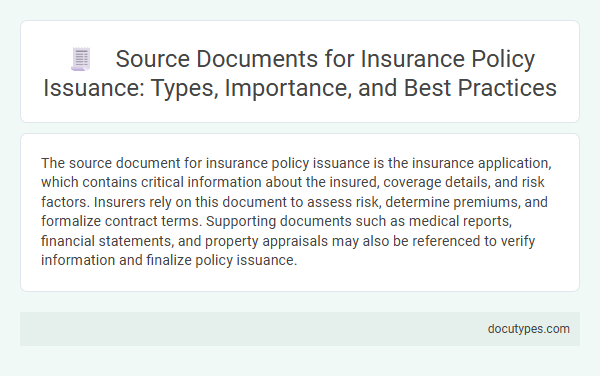The source document for insurance policy issuance is the insurance application, which contains critical information about the insured, coverage details, and risk factors. Insurers rely on this document to assess risk, determine premiums, and formalize contract terms. Supporting documents such as medical reports, financial statements, and property appraisals may also be referenced to verify information and finalize policy issuance.
Introduction to Source Documents in Insurance
Source documents in insurance are the foundational records that initiate and support the issuance of an insurance policy. These documents capture essential information about the insured party, coverage details, and risk assessment.
The most common source document for insurance policy issuance is the insurance application form, which collects personal and risk-related data from the applicant. Underwriting reports and inspection certificates also serve as critical source documents by verifying the accuracy of the information and risk factors. Together, these documents ensure that the insurance policy is issued based on factual and verified data, facilitating transparency and compliance in the insurance process.
Key Types of Source Documents for Policy Issuance
The source document for insurance policy issuance serves as the foundational record containing all essential information required to create and validate the policy. It ensures accuracy and compliance by providing verified details about the applicant and the coverage terms.
Key types of source documents for policy issuance include the insurance application form, which outlines the personal and risk information of the insured. Medical reports, proof of ownership, and previous insurance records also play crucial roles in substantiating the details needed for underwriting.
Your application form acts as the primary source document, capturing vital data such as identity, coverage preferences, and risk factors. Additional documents like claims history or third-party evaluations may further support the issuance process by confirming the accuracy of the provided information.
Role of Identification Documents in Insurance
The source document for insurance policy issuance primarily includes identification documents that verify the identity and eligibility of the policyholder. These documents are crucial in preventing fraud and ensuring accurate policy records.
- Role of Identification Documents - Identification documents such as passports, driver's licenses, and national ID cards serve as primary proof of identity for insurance applicants.
- Verification Process - Insurers use these documents to validate personal details, ensuring the legitimacy of the policyholder and compliance with regulatory requirements.
- Impact on Policy Issuance - Accurate identification supports proper risk assessment and helps in generating reliable insurance contracts, reducing claims disputes.
Importance of Financial Records in Underwriting
What is the source document for insurance policy issuance? The source document is typically the financial records submitted by the applicant. These records provide critical data that underwriters analyze to assess risk and determine policy terms.
Why are financial records important in underwriting insurance? Financial records offer a detailed history of the applicant's financial stability and potential liabilities. Underwriters rely on this information to make accurate risk evaluations and pricing decisions.
Legal Agreements and Their Impact on Policy Validity
The source document for insurance policy issuance typically involves a legal agreement between the insurer and the insured. This document outlines the terms, conditions, coverage limits, and obligations essential for activating the insurance contract.
Legal agreements establish the policy's validity by defining rights and duties, which protect both parties in case of disputes or claims. The accuracy and completeness of the source document directly impact the enforceability and clarity of the insurance policy.
Common Mistakes in Collecting Source Documents
The source document for insurance policy issuance typically includes the application form, proof of identity, and any prior insurance records. Common mistakes in collecting source documents involve submitting incomplete or outdated identification and failing to provide accurate property details. Ensuring Your documents are thorough and current helps prevent delays and policy issuance errors.
Best Practices for Verifying Document Authenticity
| Topic | Details |
|---|---|
| Source Document for Insurance Policy Issuance | The source document is the foundational paperwork required to issue an insurance policy. This typically includes the signed application form, proof of identity, and any supporting documents relevant to underwriting, such as medical reports or property valuations. |
| Importance of Source Document | Source documents establish the validity and specificity of coverage, enabling insurers to assess risk accurately. These documents form the legal basis for the insurance contract, ensuring compliance with regulatory requirements. |
| Best Practices for Verifying Document Authenticity |
|
| Role of You in Verification | You play a critical role by providing accurate and complete documentation at the start of the insurance issuance process. This supports faster verification and helps secure your policy with confidence. |
Regulatory Requirements for Insurance Documentation
The source document for insurance policy issuance is primarily the insurance application submitted by the prospective policyholder. Regulatory requirements mandate that this document contains accurate and complete information to ensure compliance with underwriting standards and legal guidelines. Insurance companies must retain these documents as part of their records to support policy issuance and facilitate audits by regulatory authorities.
Digital vs. Physical Documents: Pros and Cons
Understanding the source document for insurance policy issuance is crucial for accuracy and proof of agreement. The debate between digital and physical documents highlights key advantages and disadvantages for insurers and policyholders.
- Digital Documents Offer Speed - Digital documents enable faster processing and immediate access, streamlining policy issuance and reducing delays.
- Physical Documents Provide Tangibility - Physical documents offer a tangible proof of insurance that some users may find more reassuring and easier to store securely offline.
- Security and Fraud Risks Differ - Digital documents face cyber threats but allow encryption, while physical documents risk loss or damage but are immune to hacking.
What Is the Source Document for Insurance Policy Issuance? Infographic

